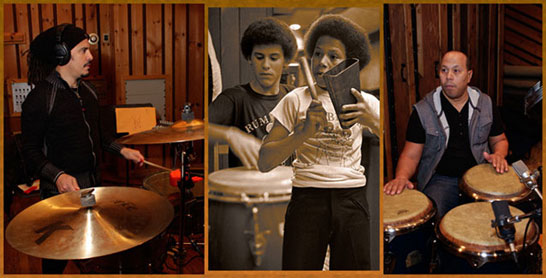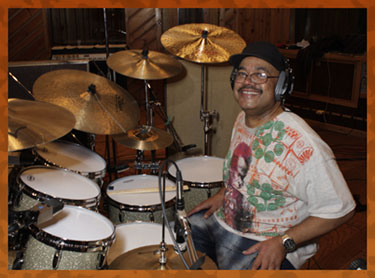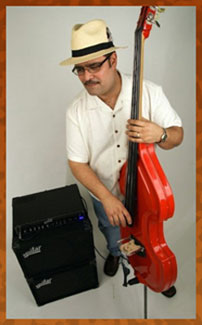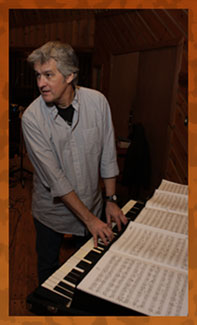

|
Soundclip:
|
| See Steve's Hand-Written Lead
Sheet |
|
Steve
Khan's
lead
sheet:  Then, one day while playing it by myself, I had this horrifying realization that, rhythmically speaking, it might actually be reminiscent of "Change Agent" from "PARTING SHOT." How embarrassing would that be? I would have been plagiarizing myself! There are any number of wonderful old musician jokes about this, but I suppose that my favorite cynical saying is this: "Everyone writes the same 3 tunes over, and over, and over again!" Well, let's face it, it's good for a laugh, and in a creative process like this, if you can't, at times, laugh at yourself, you're going to be in a lot of trouble!!! I think that this is one of the great lessons I learned from all the years that I spent working with bassist Will Lee, he taught me to laugh at myself! Then, one day while playing it by myself, I had this horrifying realization that, rhythmically speaking, it might actually be reminiscent of "Change Agent" from "PARTING SHOT." How embarrassing would that be? I would have been plagiarizing myself! There are any number of wonderful old musician jokes about this, but I suppose that my favorite cynical saying is this: "Everyone writes the same 3 tunes over, and over, and over again!" Well, let's face it, it's good for a laugh, and in a creative process like this, if you can't, at times, laugh at yourself, you're going to be in a lot of trouble!!! I think that this is one of the great lessons I learned from all the years that I spent working with bassist Will Lee, he taught me to laugh at myself!If, for a tune like this, I have arrived at some form of a compositional style, it is that the Intro would be followed by another section, which here I have labeled as [I2], and it serves as an exposition of a form, a blues-like form, and a sequence of chord changes that could relate to what follows. In my mind, I believe that I wanted to write some kind of a 12-bar blues form, but as my instincts guided me through the harmonies, it never seemed to work out like that. We get to bar 9 and yes, there it is, a V7 chord, but the motion of these harmonies leads me to ending-up with 2 extra bars. So now there are 14 bars, and I am betwixt and between, I don't have a 12-bar blues, and I don't even have a 16-bar blues!!! As the small details of the tune came to me over time, the last piece of the puzzle was that from bar 8 through 12, only having the top voice of each chord, just did not sound or feel melodically strong enough. I felt that the best solution would be to compose a line that could be sung in vocalese that would touch upon the top voice of the chords, but could exist as a melody unto itself. As it turned, I felt that this was a vocal that I could handle myself, and that's what you now hear. The other little orchestrational touch that I added was to double the electric guitar lines with my Martin MC-28 steel-string acoustic. In the end, it is a bit difficult to actually discern that this instrument is there. It's a tough texture to cut through. Another superb Marc Quiñones timbal break and avanico leads us into the [A] melody section. This time, the section is not anything like the single-note line melody section for "Change Agent." For "Bait and Switch" the single-note melodies are punctuated by chordal passages that, all or in part, appeared during [I2]. You can see this in bars: 4, 8, and 13-14. For this section, the vocalese portion, between bars 16-24 is different to accommodate this extend part of the section. Now that we have made it this far, it becomes the perfect moment to sing the praises of the great Rob Mounsey. When I was composing this melody, I felt that I wanted to pay tribute to the linear imagination of Joe Zawinul. As this tune is fundamentally a blues, I had always loved the way that Joe seemed to playfully use the most vanilla note in any blues, the major 3rd. He somehow always made it sound great. When I had the privilege of playing with him in Weather Update during the summer of 1986, I remember rehearsing a tune called "China Blues" and that tune was filled with melodic material like this. So, to more fully realize this homage, I asked Rob if he could create a melodic sound that would be reminiscent of one of Joe's double-reed synth creations. And, sure enough, Rob came-up with something fantastic, and this creates a wonderful melodic blend with the guitar. One of the last little touches of orchestration to go on this tune was that I also asked Rob if could create the always effective and evocative "bells" sound to mark the vocalese melodies.  As we did on "Zancudoville" from "PARTING SHOT," I love how this sound blends with the voice. As we did on "Zancudoville" from "PARTING SHOT," I love how this sound blends with the voice.As we emerge from the [A] section, I wanted to have a sub-section to serve as a rocket to send the piece off into the solo section. So, the 8-bars you see at the top of Pg. 3, where 6 of those bars are now labeled as letter [B], are filled with accents for Marc to make the most of. However, this particular solo section was going to be made-up of two very distinct parts, the first, labeled as [B2] would serve as a Prelude to what I would consider to be the actual solo. [B2] is 32-bars in length, after really hitting it hard during the [A] melody section, the dynamics bring us down to a more mysterious and very funky mood. How did this come about? There's an old Roger Hawkins drum groove that I have loved for years, and it appears on Herbie Mann's album, "MUSCLE SHOALS NITTY GRITTY"(1970), and on the tune titled, "Can You Dig It," and for some reason, I had the crazy idea that something like this could work in this section. One of the more fun aspects about recording both "PARTING SHOT" and "SUBTEXT" is that Dennis Chambers has come to New York and stayed at my apartment with me. This, of course, gives us a chance to catch-up on the present, share stories, and laugh about the past. And, as we're always in a 2-day crunch to record all the music, there's some quiet time where I can answer any questions Dennis might have about the various tunes, and we can go over my ideas, which can be used or discarded. But, at the very least, they get expressed and considered. And so, the night before the sessions were to begin on January 29th, 2014, Dennis and I came into the music room and I played him that Roger Hawkins groove and asked him if he thought that this could fit in the [B2] section. So, we went to the demo that I had prepared for "Bait and Switch" and Dennis listened to those sections side-by-side, he smiled and said, "Yeah, that'll work!!!" And so, in two important ways, the mood was now set for [B2]. Harmonically speaking, there's really nothing to it. I am just playing over a sustained C7 chord, and initially the orchestration is only playing two notes, C-Bb, at middle 'C.' I like this device a lot because it somehow sounds like more is going on, but it's not, and you have the room to explore harmonies with your lines. As the section unfolds, various altered tones are added to those two notes, and the improvisation is loosely affected.  Still the order of the day is to always stick closely to blues-related material, even if some of it sounds a bit sideways. All the while, Dennis Chambers is layin' down some serious fatback that just makes you wanna get up and shout, "Good God!!!" And, when Dennis was listening to a playback, that's exactly what he said. It was so great, so very, very funny!!! Still the order of the day is to always stick closely to blues-related material, even if some of it sounds a bit sideways. All the while, Dennis Chambers is layin' down some serious fatback that just makes you wanna get up and shout, "Good God!!!" And, when Dennis was listening to a playback, that's exactly what he said. It was so great, so very, very funny!!!After this Prelude, we hit the true solo form for 4 choruses of a 16-bar blues form between [B3]-[B6]. Again, the groove changes as Marc Quiñones moves from his cha-cha bell to the mambo or salsa bell, and that is joined by the campana on the other side of the mix. All the while, as he played at the top of the tune and through the [A] section Dennis is playing a cymbal pattern that I have loved since I was a teenager. It comes from an old Cal Tjader tune titled "Soul Motion." Thank goodness Dennis likes this groove, and as he played on "Change Agent," he does it here too, and with a big smile. You can't have a better person/drummer to work with than Dennis Chambers!!! Again, fundamentally we have a 16-bar blues form, but bars 9-12 are a little different, featuring 2 bars of Abm7-Db7 and 2 bars of Gbm7-B7. If one had been expecting to hear G7(V7) to F7(IV7), you could choose to view these new changes in this way: that Db7 is the b5 substitute for G7, and likewise B7 is the b5 substitute for F7. In the end, both chords surround our real center of C7 by a 1/2-step above and a 1/2-step below. It works out nicely to play over. For the 4th chorus, [B6], I did something a bit unusual by not actually completing the full 16-bars. So for this one chorus, bars 13-14 become a little break figure. After all the relentless grooving of this particular tumbao, we have a nice break, and once again, Marc and Bobby Allende create one of the great 2-bar percussion breaks on the entire album. I really love this one, and it serves to beautifully shoot us into the [C] section which is composed of completely new material and serves as a contrast to everything that has come before. As you can see from the photo collage of Marc and Bobby, their friendship, musical and personal, goes back to a time when they were just kids. This is why they love playing together so much and can be so creative when it comes to making-up fantastic "Percussion Break" figures. Yes, it's easy enough for me to write "Percussion Break" and hope that they're going to come-up with something fantastic, because I would never know how to write such a break for them.  No way!!! But, for me, it's these important little touches that make Latin music so very, very special, and without them, I can't imagine how dull music like this would be. So, I am so grateful to Marc and Bobby for all that they contributed to this recording. I just love the way they both play because their style embodies all the great traditions from Puerto Rico, but, it's also super-crisp and funky and from New York City - very Nuyorquino!!! No way!!! But, for me, it's these important little touches that make Latin music so very, very special, and without them, I can't imagine how dull music like this would be. So, I am so grateful to Marc and Bobby for all that they contributed to this recording. I just love the way they both play because their style embodies all the great traditions from Puerto Rico, but, it's also super-crisp and funky and from New York City - very Nuyorquino!!!Before I discuss the specifics of Letter [C], I think that this is a good moment to say something about how wonderful Rubén Rodríguez' Baby Bass sounds on this tune, and 3 others on the album. Unfortunately, at the time of the session that photographer Rick Laird attended, we were not playing a tune on which the Baby Bass appeared, so I never got a great photo of Rubén playing his beautiful instrument. So, I'm using one of his promo photos for Aguilar Amps to show the axe!!! Anyone who knows anything about Latin music in New York City and beyond, knows that Rubén Rodríguez is one of the great masters of his instrument. He overflows with the history of the music and always plays with impeccable good taste and a rock solid tumbao. Like the other guys, he's a superb musician and a great, great person to be around. I love the guy, and loved having him on this recording. Dynamically speaking, for [C], as a band, we come way down, even though Dennis reprises that fatback groove you heard during [B], the prelude to the solo. The harmonies in the section serve as a way to eventually lead us to an Eb/F sonority, in essence our IV7 chord, which allows us to play our familiar break figure that leads us to [I3]. This little 8-bar section almost reprises the Intro from the top of the tune, but, in bars 7-8 an extra harmonic twist is added in to lead us back to a full reprise of our [A] melody. But not before the "2-bar Percussion Break" is filled spectacularly by Bobby Allende! ¡Eso papá! As we emerge from letter [A], we have one last little percussion break where Marc and Bobby do a wonderful levanta, which, in this case is like a mini-crescendo leading into the accented hits before we arrive at the Coda and letter [D]. Without having written in anything special here, as an arranger, I suppose that I really did mess this up, because something that should have happened in these 4 bars was to serve to get us into [D2] which is the ride-out and a vehicle for Dennis Chambers to have a long drum solo. As it turned out, "Bait and Switch" closes the album, and Dennis has the last word. But, the truth is that I did not really give the band any great directions as to how to approach [D] and because of my oversight, nothing happened, and there was no contrast leading to Dennis' solo.  This put Rob Mounsey and I in a most difficult place during the editing phase of the recording process. How could we make something out of nothing? We thought of various ideas to break down the instrumentation, but, in the end, it was Rob's suggestion to just mute the Baby Bass and that this would serve as enough of a contrast, so that when the bass returns, Dennis' solo begins. This is what you now hear. But again, in defense of the players, these 4 bars were really not well thought-out by me, the arranger!!! I will always regret this a bit, but, it's way too late now!!! This put Rob Mounsey and I in a most difficult place during the editing phase of the recording process. How could we make something out of nothing? We thought of various ideas to break down the instrumentation, but, in the end, it was Rob's suggestion to just mute the Baby Bass and that this would serve as enough of a contrast, so that when the bass returns, Dennis' solo begins. This is what you now hear. But again, in defense of the players, these 4 bars were really not well thought-out by me, the arranger!!! I will always regret this a bit, but, it's way too late now!!!It's worth it to say that, like "PARTING SHOT," James Farber recorded and mixed "SUBTEXT" and again he did a wonderful job. For me, one of the crucial differences in the sound design between the two albums is that, on the new recording, I had asked Marc Quiñones if we could record the percussion a bit more "old school" than "PARTING SHOT" and by that I meant that we would record the campana, the bongo bell, separate. And, as it does on most of the classic Salsa recordings, the campana almost always appears on the opposite side of the mix from the mambo bell of the timbalero. On this album, Marc is on the left side and Bobby is on the right side, and when the campana appears, it is on the right side. For me, I like this blend much better, and it's a bit easier to keep both bells in balance. As James and I, especially me, are not as young as we used to be, the thought of killing ourselves trying to do 5 mixes one day, and 4 the next day just seemed impossible, physically speaking. It probably would have necessitated some serious "vampire hours," and leaving the studio as the sun was coming up, getting a couple hours of sleep, and coming right back for the 2nd day. We talked about this, and even though it would be more expensive, we decided that the most prudent course of action would be to just mix 3 tunes per day, and try to really get them done!!! That was our plan, that's the way we did it, and even with all that care and planning, we still needed an extra day to "recall" several of the mixes to make small but necessary adjustments. In the end, it was still exhausting. Perhaps, this is much more of a young man's game? About the title, "Bait and Switch"? I've always liked this expression, as I associate it with the trickery and larceny of the great "confidence men" or con men. They lure the "mark" in, making him think that he's going to be getting one thing, and then, at the last moment, faster than the eye can see, the items are switched, and the mark ends-up with a piece of junk!!! In Spanish there's really no expression that is exactly common to this one, but my dear friend, Felipe Díaz was able to once again present me with a subtitle in Spanish, "Gato por liebre" which means, in a restaurant, the chef substitutes the meat from a "cat" for that of a "hare"!!! Doesn't sound too appealing, now does it? Just recently, in April-May of 2014, I was watching a novela, more like a series of short stories, from Colombia, "CONFIDENCIAL" presented by Caracol Internacional, and one of the short stories presented was about a master con man, and, for the first time, I heard the verb, estafar, and had to look it up in my Spanish dictionary. I saw that it meant, to swindle. Then, later in the story, one of the frustrated cops, trying to catch him, referred to the criminal as "El Estafador" and I said to myself, "Wow, that should have been my Spanish subtitle!!!" Sometimes, a great subtitle does not have to be a literal translation of the title. Oh well, sometimes you learn something new, but just a little bit too late!!! Again, if one is doing a recording of Latin Jazz, it is always nicer to have Spanish subtitles for as many of the tunes as is possible, and with Felipe's help I tried to do that. And now, of all things, my dear friend, saxophonist Rafael Greco, based upon this new information, has given me a new nickname: "El Estifador." This, I really like!!! Risas por favor!!! The release of any recording is a most special moment, and it is always filled with a sense of hope, however misguided that hope might be. It's an exciting and anxious series of moments because, one never knows if the people you hope to reach will even hear the music, and, the people you might never expect to reach might never hear any of it as well. But, in the same breath, one can still hope that people will get to hear something, and that their response will be favorable. But that is the great adventure in all this, because one can't count on any of it. So, if you have even reached this portion of what I have written, I'll take it as a sign that perhaps, just perhaps, you have heard something that has drawn you to this page. On this June 24th, 2014, I remain hopeful that you will enjoy more of what we all created together while making "SUBTEXT." Thanks to everyone for listening!
[Photos: Steve Khan; Dennis Chambers; and Rob Mounsey by Richard Laird
Marc Quiñones and Bobby Allende by Richard Laird("Now") and Martin Cohen("Then") Photo: Rubén Rodríguez by Aguilar Amplification] |